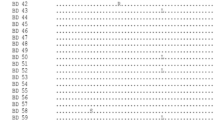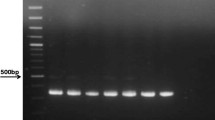Abstract
Hepatitis B virus (HBV) surface antigen (HBsAg) is a reliable marker for HBV infection, but HBsAg-negative forms of HBV infection occur. The introduction of HBV DNA screening of Dutch blood donors, which were not preselected for absence of HBV core antibodies, enabled the characterization of HBsAg-negative HBV infection in healthy persons and a comparison of the HBV genomes involved. The screening of 4.4 million Dutch blood donations identified 23 HBsAg-negative, HBV DNA-positive persons. Serological testing of the index donations, follow-up samples and archived earlier samples was performed to determine the nature of each HBV DNA-only case. Despite low viral loads HBV DNA could be sequenced in 14 out of 23 donors, allowing HBV genotyping and the analysis of mutations in the HBV surface gene. Four types of HBsAg-negative HBV infection were detected: infection in the early stage before occurrence of HBsAg; suppressed infection after vaccination; HBV genotype G infection with decreased HBsAg production; and chronic occult (HBsAg negative) HBV infection. In the donors with occult HBV genotype D infection the HBV surface gene showed multiple “escape” mutations in the HBsAg a-determinant and CTL epitopes, while in an occult genotype A case the surface gene showed no mutations. HBsAg-negative forms of HBV infection in healthy blood donors explain the ongoing transmission of HBV via blood transfusion, if donor screening is limited to HBsAg. The screening of blood donors for HBV DNA and HBV core antibodies seems to cover all stages and variants of HBV infection.


Similar content being viewed by others
References
Assal A, Barlet V, Deschaseaux M et al (2009) Sensitivity of two hepatitis B virus, hepatitis C virus (HCV), and human immunodeficiency virus (HIV) nucleic acid test systems relative to hepatitis B surface antigen, anti-HCV, anti-HIV, and p24/anti-HIV combination assays in seroconversion panels. Transfusion 49:301–310
Kleinman SH, Busch MP (2006) Assessing the impact of HBV NAT on window period reduction and residual risk. J Clin Virol 36 [Suppl 1]:S23–S29
Gunther S, Li BC, Miska S et al (1995) A novel method for efficient amplification of whole hepatitis B virus genomes permits rapid functional analysis and reveals deletion mutants in immunosuppressed patients. J Virol 69:5437–5444
Zaaijer HL, Boot HJ, van Swieten P et al (2011) HBsAg-negative mono-infection with hepatitis B virus genotype G. J Viral Hepat 18:815–819
Tamura K, Peterson D, Peterson N et al (2011) MEGA5: molecular evolutionary genetics analysis using maximum likelihood, evolutionary distance, and maximum parsimony methods. Mol Biol Evol 28:2731–2739
Candotti D, Grabarczyk P, Ghiazza P et al (2008) Characterization of occult hepatitis B virus from blood donors carrying genotype A2 or genotype D strains. J Hepatol 49:537–547
Zaaijer HL, Torres A, Ontañón L et al (2008) Multiple surface antigen mutations in five blood donors with occult hepatitis B virus infection. J Med Virol 80:1344–1349
Stuyver LJ, Locarnini SA, Lok A et al (2001) Nomenclature for antiviral-resistant human hepatitis B virus mutations in the polymerase region. Hepatology 33:751–757
Desmond CP, Bartholomeusz A, Gaudieri S et al (2008) A systematic review of T-cell epitopes in hepatitis B virus: identification, genotypic variation and relevance to antiviral therapeutics. Antivir Ther 13:161–175
Kazim SN, Sarin SK, Sharma BC et al (2006) Characterization of naturally occurring and Lamivudine-induced surface gene mutants of hepatitis B virus in patients with chronic hepatitis B in India. Intervirology 49:152–160
Kim JH, Jung YK, Joo MK et al (2010) Hepatitis B viral surface mutations in patients with adefovir resistant chronic hepatitis B with A181T/V polymerase mutations. J Korean Med Sci 25:257–264
Chudy M, Schmidt M, Czudai V et al (2006) Hepatitis B virus genotype G monoinfection and its transmission by blood components. Hepatology 44:99–107
Allain JP, Candotti D (2012) Hepatitis B virus in transfusion medicine: still a problem? Biologicals 40:180–186
Levicnik-Stezinar S, Rahne-Potokar U, Candotti D et al (2008) Anti-HBs positive occult hepatitis B virus carrier blood infectious in two transfusion recipients. J Hepatol 48:1022–1025
Satake M, Taira R, Yugi H et al (2007) Infectivity of blood components with low hepatitis B virus DNA levels identified in a lookback program. Transfusion 47:1197–1205
Van Houdt R, Bruisten SM, Koedijk FD et al (2007) Molecular epidemiology of acute hepatitis B in the Netherlands in 2004: nationwide survey. J Med Virol 79:895–901
Van Houdt R, Bruisten SM, Geskus RB et al (2010) Ongoing transmission of a single hepatitis B virus strain among men having sex with men in Amsterdam. J Viral Hepat 17:108–114
Seed CR, Jones NT, Pickworth AM et al (2012) Two cases of asymptomatic HBV “vaccine breakthrough” infection detected in blood donors screened for HBV DNA. Med J Aust 196:651–652
Stramer SL, Wend U, Candotti D et al (2011) Nucleic acid testing to detect HBV infection in blood donors. N Engl J Med 364:236–247
De Maddalena C, Giambelli C, Tanzi E et al (2007) High level of genetic heterogeneity in S and P genes of genotype D hepatitis B virus. Virology 365:113–124
Bes M, Vargas V, Piron M et al (2012) T cell responses and viral variability in blood donation candidates with occult hepatitis B infection. J Hepatol 56:765–774
Huang CH, Yuan Q, Chen PJ et al (2012) Influence of mutations in hepatitis B virus surface protein on viral antigenicity and phenotype in occult HBV strains from blood donors. J Hepatol 57:720–729
Acknowledgement
This study was funded by Sanquin Blood Supply Foundation, a non-profit organization.
Conflict of interest
The authors declare that they have no conflict of interest.
Author information
Authors and Affiliations
Corresponding author
Electronic supplementary material
Below are the links to the electronic supplementary material.
Supplementary material 1
(DOC 52 kb)
Supplementary material 2
(DOC 52 kb)
Rights and permissions
About this article
Cite this article
Lieshout-Krikke, R.W., Molenaar-de Backer, M.W.A., van Swieten, P. et al. Surface antigen-negative hepatitis B virus infection in Dutch blood donors. Eur J Clin Microbiol Infect Dis 33, 69–77 (2014). https://doi.org/10.1007/s10096-013-1930-9
Received:
Accepted:
Published:
Issue Date:
DOI: https://doi.org/10.1007/s10096-013-1930-9




